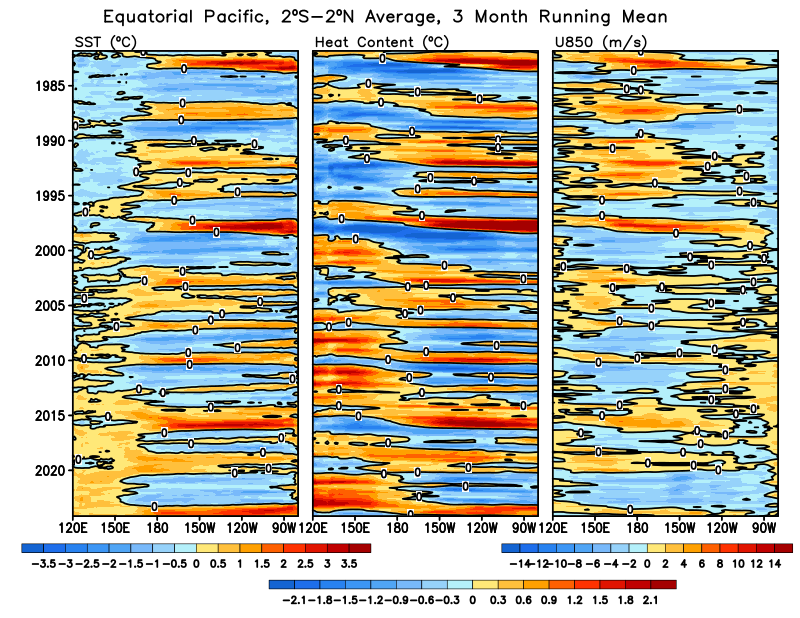Craig, not to confuse, but what I meant was not to suggest that ENSO can change (and mature) from one state to the next in a matter of days--only that, in a case like 1997, the sea surface temperatures had been in a La Niña state in the early months of the year, while below the surface, the ocean had been warming up for several weeks. By the end of the month, the cool waters had rapidly subsided, and the warm waters from an eastward propagating Kelvin wave began to dominate. It's clear that in April 1997, that was the point at which the trade winds finally "broke down" and the positive feedback towards El Niño began relentlessly.

The actual El Niño event did take several months to fully build (beginning April 1997 and peaking in late November 1997):
http://www.cpc.ncep.noaa.gov/data/indices/wksst8110.forWhat is impressive to me was how early things began heating in the eastern Pacific, in late April no less. In the most recent 2009-2010 El Niño, the vital signs of the event were barely present until June 2009. Weak El Niños like 1995 and 2007 had little going on until about September of their respective previous years. I suppose this meant that the earlier maturity of 1997 helped prolong the monster's ability to amplify to the size it did, finally releasing heat to the atmosphere as the seasons changed over to the northern winter of 1997-1998. And I wonder aloud (perhaps pointlessly at this stage) if we may see an early development this year. Who knows.
But Jim, I understand what you're saying, and I suppose my "excitement" is a bit vain, though it's purely from an academic standpoint. It's said that ENSO, as an unforced internal variability, should balance over the long term, and as it's internal, it really has no bearing on the overall trend, and its effectiveness in global warming is how it distributes heat from the ocean to the atmosphere. Of course, when discussing time scales (particularly human ones), one's idea of "long term" differs. If La Niña dominates for 100 years, do we still have similar temperature projections by 2100 compared to if El Niño dominates? Your mileage may vary. I am in the dark there. We are still grasping with just how unique the phenomenon of El Niño actually is against the paleo record. Some of its history (dominance versus absence) is posited to have had to do with orbital forcing and deglaciation, at least in terms of the Holocene. The idea of what is "normal" is slippery to grasp, indeed, especially in climate history when we deal with unimaginably significant variables: atmospheric conditions, plate tectonics and thermohaline circulation, insolation, volcanoes, etc. So many circumstances that scientists translate to our present time with care.
Whether we are entering a period in which one form of ENSO or another is absent or dominant, or just more of the same, the recent literature remains confusing to say the least. On one hand, some have saying the Walker Circulation will strengthen from AGW and that this fuels La Niña; others say a weaker Walker Circulation is still possible; others suggest that a warming western Pacific will result in more frequently intense El Niños. I honestly have no idea, and I agree in a way that no El Niño with a record temperature would be more interesting than having an El Niño with a record. It's certainly more unique and harder to explain than simply "Oh, 2015 was an El Niño, so carry on."
I saw in another thread you were asking about paleo records for El Niño. I'm reading through some to see if they address your question and will try to help you soon as I find something useful. You might seek out some of Mark Cane's work. He has done much on the subject, including its history.
